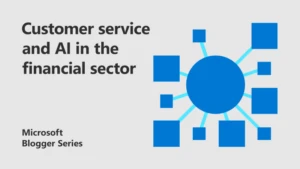
How financial institutions can digitise and automate business processes with no/low code

Digital modernisation is quickly becoming critical for business success in financial services. Especially in areas like customer experience and business process efficiencies. But the key to any modernisation is innovation. As a result, many financial institutions now see value in digitising and automating business processes to address three challenges:
- How to provide more authentic and personalised customer experiences.
- Reducing business process inefficiencies.
- How to digitally transform and innovate whilst needing to maintain existing core and legacy systems.
With simple and effective no/low code applications such as Microsoft Power Apps, organisations are finding innovative ways to manipulate data and overcome these challenges. This makes these quick and easy-to-develop business apps a common solution across financial services. Here’s some examples of how this technology is being implemented.
Creating a more valuable customer experience
The expectation around customer experience is changing, resulting in more customers showing a lack of loyalty to financial brands. According to Gartner, “banking customers are increasingly demanding authentic human interactions.” This is a level of service that financial organisations need to provide across all channels to boost their customer engagement and loyalty.

When thinking about human interactions, automation may seem like a step in the wrong direction. But by digitising operational processes in the backend, financial institutions are finding innovative ways to free-up employees. As a result, they can focus on delivering the best customer experience.
Metro Bank for example has driven down many of its business inefficiencies by innovating with a retail experience in mind. In-store greeters now use a tablet with Power Apps to access a customer’s details the moment they walk through the door. This helps appointments feel more efficient and personal. If meetings over-run, the customer is free to leave the bank and is notified via text message when to come back for their appointment.
Another great example is how Standard Bank’s mobile application helps digitise the process for maintaining ATMs. Developed in Power Apps in just 24 hours, it allows employees to geotag and update a machine’s status during routine inspections. Automation in the backend then categorises the data and flags any issues to the appropriate department. This ensures an ATM is promptly fixed to help maintain a premium brand image for customers.
Finding and solving business inefficiencies
If business processes are negatively impacting an organisation’s performance, financial institutions should look for a solution with two aims. One, to reduce inefficiencies and two, increase profitability.
Automation can play a key role in both goals and provide a range of business benefits. It can remove paper-based processes, reduce the risk of human error and offer better access to data insights.
UK insurer William Russell has done just that by creating a Power App solution to automate its online quotations. This provides a faster, more efficient service for customers. Once a request has been raised, a sales agent is promptly alerted to call the customer, and provided with all the necessary information to have a productive conversation. As a result, they’ve been able to convert 50 percent more quotes into sales than before.
Removing legacy barriers to digital innovation
On average, financial institutions can spend up to 70 percent of their IT budgets on maintaining and servicing core systems and legacy applications. But by allocating resources this way, organisations reduce their time and ability to consider new innovations. At the same time, they risk delivering a poor customer experience with outdated systems.
This is a digital modernisation barrier that no/low code application and automation platforms can help address in two key ways:
- Create modern user interfaces or mobile applications that seamlessly integrate with any existing business applications, workflows and processes to change how employees interact with legacy systems.
- Extend and innovate legacy systems with Robotic Process Automation to help get more value out of a core infrastructure and ensure it can integrate with other modern applications.
The importance of innovation for financial services

Innovation is fundamental for any business growth. Whether you’re considering how to deliver more personalised customer engagement, reduce inefficiencies or implement new solutions. So if you’re considering how to begin innovating with no/low code, here’s some things to keep in mind.
Firstly, pinpoint any of your current business processes that aren’t operating as well as you’d like or delivering the right level of insights. This will help you consider what use cases could drive your transformation to improve these inefficiencies and allow you to match the technology to the best approach before investing in a solution upfront.
Innovation can come from any part of an organisation. Always get input from a mix of IT and business teams when doing this research. This ensures you understand what pain points and inefficiencies exist within your organisation. It will also help ensure any new technology you bring in will work alongside the people use it day-to-day.
If you’re not sure where to start, see how implementing common use cases such as improving manual or paper-based tasks and reducing repetitive or data-heavy processes can improve your efficiencies. Then once you’ve got the ball rolling, it’ll be easier to identify other inefficient processes that could be improved through digitalisation.
There’s a wealth of potential for no/low applications in financial services. With tools like Microsoft Power Platform, you can have a solution up-and-running in a matter of days and weeks rather than months and years.
Find out more
Discover the Total Economic Impact of Microsoft Power Automate
Watch on demand: Intelligent Operations in Financial Services: Transforming with Power Platform
Boosting the innovation of banking business models
Innovation blog (tba)
About the author

Lucy leads the financial services industry team within Business Applications at Microsoft. She is passionate about helping financial services organisations transform, delivering improved ways of working and amazing experiences for their customers and employees. She has spent her entire career in technology, mainly in the enterprise business applications space. Prior to joining Microsoft, Lucy was an early member of the Salesforce UK business. Here she spent 15 years in a variety of roles – gaining a deep understanding in how to help organisations radically transform their customer experience.




